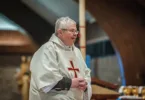
by Therese Horvat
Special to The Leaven
Across the centuries, the Jewish people have been viewed as the “other.” They have been blamed as scapegoats for Jesus’ crucifixion, the Black Death, war and struggling economies.
Based on unfounded conspiracy theories and fabricated claims of racial inferiority, Jews have suffered harassment, exclusion, violence and genocide. Christians, Catholics, Fathers of the Church, Nazis, white supremacists, and leaders and individuals given to stereotyping and to inaction have been complicit in what is called “the oldest hatred” that persists still today.
This year as the Christian observance of Holy Week coincides with the Jewish celebration of Passover, this sacred season presents a timely opportunity to probe the history and resurgence of antisemitism, and to identify ways to counter this age-old prejudice.
Origins of antisemitism date back millenia
Philip Cunningham, Ph.D., is a professor of theology and the director of the Institute for Jewish-Catholic Relations at Saint Joseph’s University in Philadelphia. He explains that even before the concepts of anti-Judaism and antisemitism existed, there was in ancient times opposition to the religious beliefs and culture of Jews, or people from Judea. The Jews resisted assimilation into the Greco-Roman cultures. They were monotheistic, considered other gods false and refused to worship them.
Jesus was a Jew in a world dominated by the Roman Empire that tolerated Judaism. Cunningham says that because of Jesus’ teachings, the Roman overlords perceived him as someone planning an insurrection.
“‘Who crucified Jesus?’ is a historic question. The decision to crucify Jesus was made to enforce Roman rule,” Cunningham clarifies. “‘Who was to blame?’ was a matter of judgment.”
Subject to Roman rule, the early Christians couldn’t very well cast blame on Pontius Pilate for Jesus’ crucifixion. The blame fell instead to Jewish Temple leadership and, in time, broadened to encompass the Jewish people.
The notion of the “blood curse” associated with the Crucifixion prevailed for centuries.
From anti-Judaism to antisemitism
Early Christianity started out as a movement within Judaism. However, with the rise of Christianity, church leaders sought to promote the religion as the successor to Judaism. There were forced conversions of Jews. Some theologians and Fathers of the Church called out “the Jews” as Christ-killers. Cunningham says we need look no further than St. Augustine for examples: He wrote that because of the Crucifixion, Jews were cursed to wander the earth aimlessly.
In the Middle Ages, the Catholic Church gained unprecedented influence and power. Anti-Jewish beliefs became institutionalized in laws restricting freedoms. Jews could neither marry nor employ Christians. They were denied citizenship and civil liberties, isolated in ghettos, made to wear identifying yellow badges and expelled from some countries. Judaism drew attacks as a religion.
Conspiracy theories flourished. When Christian children went missing, Jews were accused of kidnapping and murdering them to use their blood to make Passover bread. It was alleged that Jews caused the Black Death by poisoning water in wells they were forbidden to use.
During the Crusades, Christians wiped out Jewish villages and massacred Jews under the cry “be baptized or die.” Popes issued statements condemning the violence. They taught that while Jews should not be harmed or killed, nor should they be given any special rights.
“The idea that God was collectively punishing Jews for killing and/or rejecting Jesus was pervasive throughout European Christianity,” said Cunningham. “Jews were allowed to survive but not thrive.”
More broadly, Judaism as a religion came under attack in a variety of ways. Sacred texts were burned. In the 1500s, when Jews refused to convert to Martin Luther’s vision of a reformed church, he lobbied against them and for destruction of their synagogues and homes. Luther wrote a pamphlet titled “The Jews and Their Lies” that the Nazis republished in the 20th century.
In the late 1800s, the theory emerged that Jewishness was more of a biological than a religious matter. A German writer and politician coined the word “antisemitism,” expressing bias against Jews as a race. This belief consumed Adolf Hitler and the Nazi ideology, which blamed the Jews for Germany’s loss in World War I. It went on to blame them for the country’s economic challenges that followed the war, considered them a menacing threat and set out to eliminate them as an inferior race.
From 1933 to 1945, this led to the systematic slaughter of six million Jews. Catholic responses ranged from opposing Nazism to embracing the ideology and defending it theologically on the basis that the Jews committed the second original sin.
Meanwhile, at different times throughout U.S. history, Jews faced discrimination on the basis of their religion, mannerisms, customs and efforts to advance. Quotas and restrictions limited their access to educational institutions, recreational facilities, hotels and neighborhoods.
Despite this, Jews defended the nation during its wars. They were active supporters of the Civil Rights Movement of the 1950s and 1960s. White supremacists targeted both Black and Jewish communities as corrupters of white America.
And while anti-Jewish and antisemitic sentiments in this country have waxed and waned, recent years have seen a dramatic rise.
Today, the Anti-Defamation League (ADL) writes on its website: “Assault, harassment and vandalism against Jews remain at near historic levels in the United States.”
Toward a new understanding
It wasn’t until the 1960s and at the request of Pope St. John XXIII that the Second Vatican Council critiqued and studied Jewish-Christian relations. The council document “Nostra Aetate” (“In Our Time”) dispelled centuries-old notions held by Catholics, including the blood curse.
“‘Nostra Aetate’ stressed the Jewishness of Jesus, his mother and the early apostles,” explained Cunningham. “It deplored antisemitism and called Jews ‘beloved of God’ and possessors of the covenant and the promises because ‘the gifts and the calling of God are irrevocable’ (Rom 11:29).
“And finally, it urged Catholics and Jews to engage in joint study and dialogue.”
Pope John XXIII and Pope St. Paul VI were instrumental in the document’s formulation and proclamation. Pope St. John Paul II was the architect of its implementation. He had lived during the Holocaust and lost friends in the genocide. Pope John Paul had a personal commitment to the establishment of harmonious relations between Christians and Jews.
In his turn, Pope Benedict identified the need to define in a new way the relationship between the Catholic Church and the faith of Israel. U.S. Catholic bishops and leaders have spoken in solidarity with Jewish brothers and sisters, and decried recurring violence against Jews and synagogues.
Pope Francis, likewise, points to the Vatican II reforms and speaks of continuing the “journey of friendship.” Cunningham sees this journey posited on the belief that Jews and Christians both have traditions of being in covenant with God.
“Jews are partners in a covenant of eternal love that was never revoked,” he said. “This is the connecting link.”







Typical incompetent drivel. 1) There were also many Jews in the Red Army. 2) In the late 1800s, the theory emerged that Jewishness was more of a biological than a religious matter. Oh yes, this belief consumed the modern, secular ‘ Jewish’ movement to where Jews are most often defined as Hermon Gohring would have defined a Jew, never mind any adherence to Judaism. 3) And there’s no distinction of modern Jew hate being doubled because of political Zionism & the creation of secular ‘ Israel’. 4) Let alone the constant attempt to minimize Christianity’s departure from Judaism.